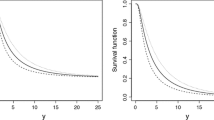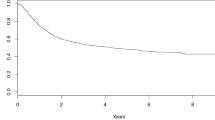Abstract
The proportional hazards cure model generalizes Cox’s proportional hazards model which allows that a proportion of study subjects may never experience the event of interest. Here nonparametric maximum likelihood approach is proposed to estimating the cumulative hazard and the regression parameters. The asymptotic properties of the resulting estimators are established using the modern empirical process theory. And the estimators for the regression parameters are shown to be semiparametric efficient.
Similar content being viewed by others
References
Andersen P.K., Borgan Ø., Gill R., Keiding N. (1993). Statistical models based on counting processes. New York, Springer
Ash R.B. (1972). Real analysis and probability. San Diego, Academic
Berkson J., Gage R.P. (1952). Survival curve for cancer patients following treatment. Journal of the American Statistical Association, 47, 501–515
Bickel P.J., Klaassen C.A.J., Ritov Y., Wellner J.A. (1993). Efficient and adaptive estimation for semiparametric models. Baltimore, Johns Hopkins University Press
Bilias Y., Gu M., Ying Z. (1997). Towards a general asymptotic theory for Cox model with entry. Annals of Statistics, 25, 662–682
Chen K., Jin Z., Ying Z. (2002). Semiparametric of transformation models with censored data. Biometrika, 89, 659–668
Cox D.R. (1972). Regression models and life tables (with Discussion). Journal of the Royal Statistical Society Series B, 34, 187–220
Fang H.B., Li G., Sun J. (2005). Maximum likelihood estimation in a semiparametric logistic/proportional-hazards mixture model. Scandinavian Journal of Statistics, 32, 59–75
Farewell V.T. (1982). The use of mixture models for the analysis of survival data with long-term survivors. Biometrics, 38, 1041–1046
Farewell V.T. (1986). Mixture models in survival analysis: are they worth the risk?. Canadian Journal of Statistics, 14, 257–262
Fleming T.R., Harrington D.P. (1991). Counting processes and survival analysis. New York, Wiley
Kress R. (1989). Linear integral equations. New York, Springer
Kuk A.Y.C., Chen C.-H. (1992). A mixture model combining logistic regression with proportional hazards regression. Biometrika, 79, 531–541
Loeve M. (1963). Probability theory. Princeton, D. Van Nordstrand Company
Lu W., Ying Z. (2004). On semiparametric transformation cure models. Biometrika, 91, 331–343
Luenberger D.G. (1969). Optimization by vector space methods. New York, Wiley
Maller R.A., Zhou S. (1996). Survival analysis with long term survivors. New York, Wiley
Murphy S.A. (1994). Consistency in a proportional hazards model incorporating a random effect. Annals of Statistics, 22, 721–731
Murphy S.A. (1995). Asymptotic theory for the frailty model. Annals of Statistics, 23, 182–198
Peng Y., Dear K.B.G. (2000). A nonparametric mixture model for cure rate estimation. Biometrics, 56, 237–243
Scharfsten D.O., Tsiatis A.A., Gilbert P.B. (1998). Semiparametric efficient estimation in the generalized odds-rate class of regression models for right-censored time-to-event data. Lifetime Data Analysis, 4, 355–391
Serfling R.J. (1980). Approximation theorems of mathematical statistics. New York, Wiley
Shorack G.R., Wellner J.A. (1986). Empirical processes with applications to statistics. New York, Wiley
Sy J.P., Taylor J.M.G. (2000). Estimation in a Cox proportional hazards cure model. Biometrics, 56, 227–236
Tsiatis A.A. (1981). A large sample study of Cox’s regression model. Annals of Statistics, 9, 93–108
Tsodikov A.D. (1998). A proportional hazards model taking account of long-term survivors. Biometrics, 54, 138–146
Tsodikov A.D. (2001). Estimation of survival based on proportional hazards when cure is a possibility. Mathematical and Computer Modelling, 33, 1227–1236
Tsodikov A.D., Ibrahim J.G., Yakovlev A.Y. (2003). Estimating cure rates from survival data: an alternative to two-component mixture models. Journal of the American Statistical Association, 98, 1063–1078
van der Vaart A.W. (1995). Efficiency of infinite dimensional M-estimators. Statistica Neerlandica, 49, 9–30
van der Vaart A.W., Wellner J.A. (1996). Weak convergence and empirical Processes. New York, Springer
Zeng D., Ying G., Ibrahim J.G. (2006). Semiparametric transformation models for survival data with a cure fraction. Journal of the American Statistical Association, 101, 670–684
Author information
Authors and Affiliations
Corresponding author
About this article
Cite this article
Lu, W. Maximum likelihood estimation in the proportional hazards cure model. Ann Inst Stat Math 60, 545–574 (2008). https://doi.org/10.1007/s10463-007-0120-x
Received:
Revised:
Published:
Issue Date:
DOI: https://doi.org/10.1007/s10463-007-0120-x




